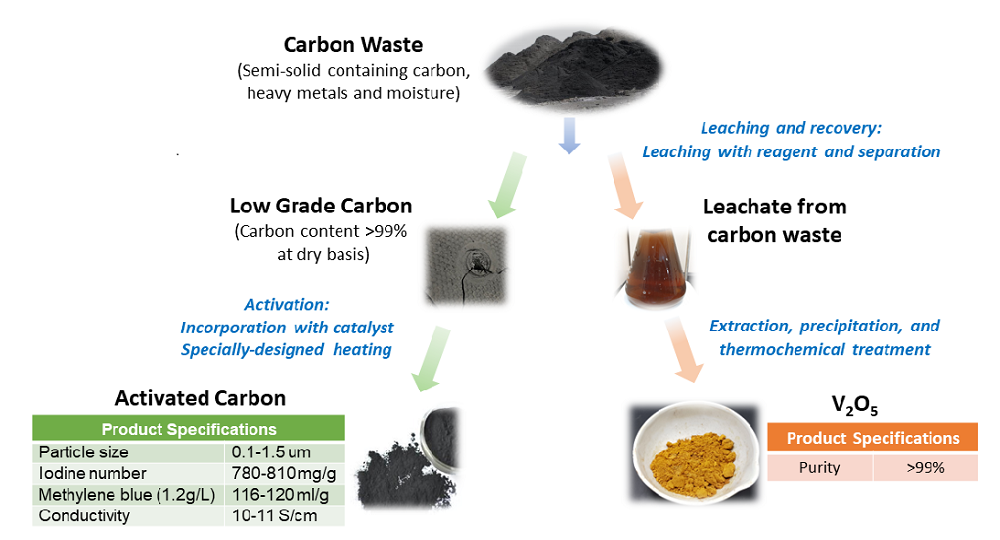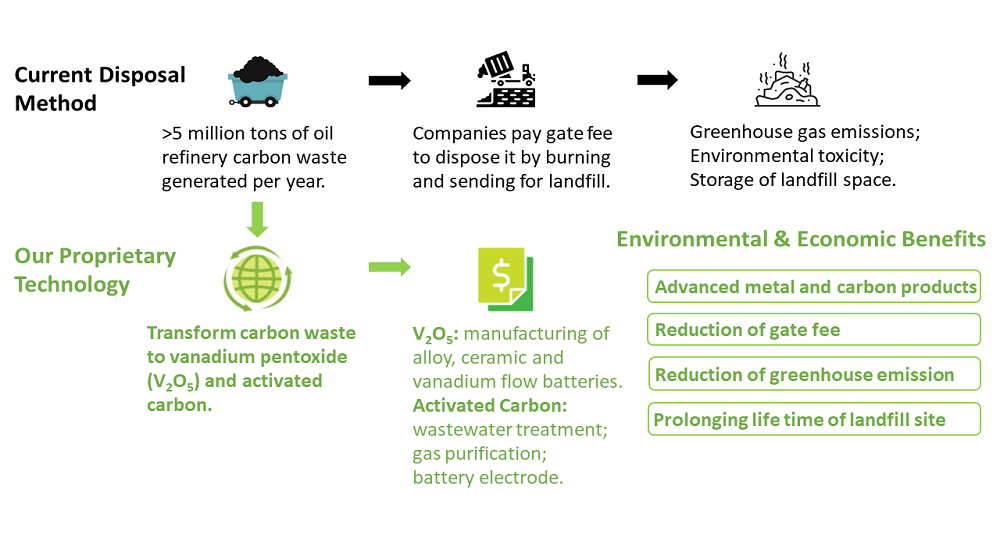Technologies
Discover, Connect & Collaborate at TECHINNOVATION 2021
Recycling Carbon Waste into High-value Products
Technology Overview
Oil refinery carbon waste contains various heavy metals and fine carbon particles with random distribution of different morphologies, which makes it difficult to be upcycled. Currently, these are just burnt off and the remaining ash would be sent to landfills.
The technology is a proprietary process, consisting of two parts:
- Leaching and recovery process, which separates heavy metals from the carbon waste in normal temperature and pressure using an environmentally friendly reagent, and then selectively convert vanadium to vanadium pentoxide. Our proprietary synthesis route is highly selective for vanadium so that the purity of final vanadium pentoxide is higher than 99%;
- Activation process, which converts the purified carbon to highly porous and surface functionalized activated carbon. A catalyst (our proprietary formulation) is coated on the carbon surface with optimal thickness, followed by optimized heating program with the presence of specific gas, such that both pore enhancement and surface functionalization could be achieved.
Through this, two products can be produced, namely activated carbon and vanadium pentoxide. Activated carbon could be used in wastewater treatment, air purification or battery electrodes, while vanadium pentoxide could be used in the manufacturing of steel alloys and vanadium flow batteries, amongst others.
This company is seeking collaboration with oil refinery companies to license the technology or scale up the process in a joint venture model.
Technology Features, Specifications and Advantages
- Recycling the oil refinery carbon waste to high-value products (activated carbon and vanadium pentoxide) instead of burning and landfill.
- Conventional methods use high temperature (>800oC) to produce activated carbon. This proprietary process enables the activation at <400oC. Solid carbon could be converted to gaseous species at high temperature. This enables a higher yield (>85%) as compared to conventional methods (<60%).
- This activated carbon has doubled adsorption capacity for Arsenic and Selenium, which are two key heavy metal pollutants in industrial wastewater.
- The vanadium pentoxide produced has a high purity (99% and above) and is cost-effective.
Potential Applications
- This technology enables recycling of the carbon waste in oil & gas industry.
- The activated carbon produced could be used in wastewater treatment, air purification or battery electrodes.
- Vanadium pentoxide produced could be used for the manufacturing of steel alloys and vanadium flow batteries.
- The global oil refinery capacity is more than 5 million tons/year, and it’s expanding at 6%. The global activated carbon market size is S$10.5 billion, and it’s expanding at compound annual growth rate of 17%. The global vanadium pentoxide market size is S$877 million, and it’s expanding at compound annual growth rate of 16%.
Customer Benefit
- Sustainable solutions for oil refinery companies to recycle carbon waste into activated carbon and vanadium pentoxide products.
- Save huge amounts of waste disposal fee (gate fee), which is several hundred Singapore dollars per ton of carbon waste.
- End users can lower their operating cost by using high-performance and cost-effective carbon and vanadium products.
- Double-sustainable solution. 1) Recycle industrial carbon waste into high-value products instead of burning & landfill; 2) Products created through this process can be further applied to treat industrial pollutants and energy storage systems.

